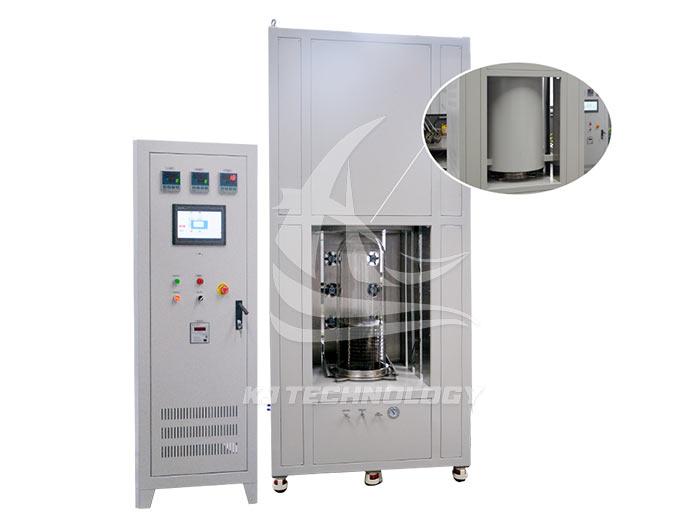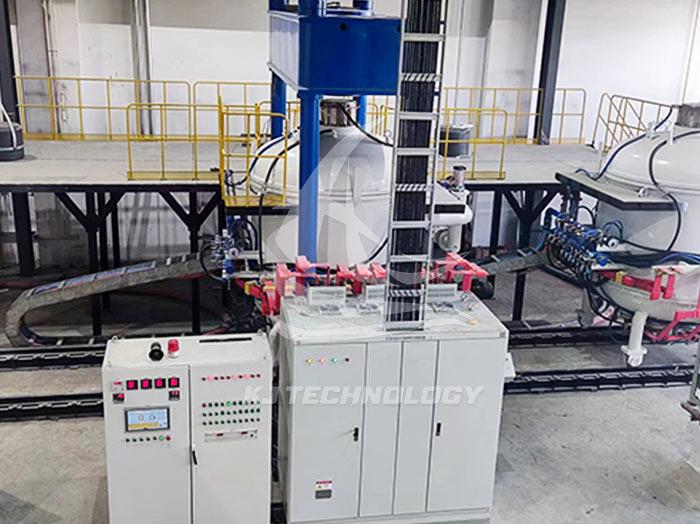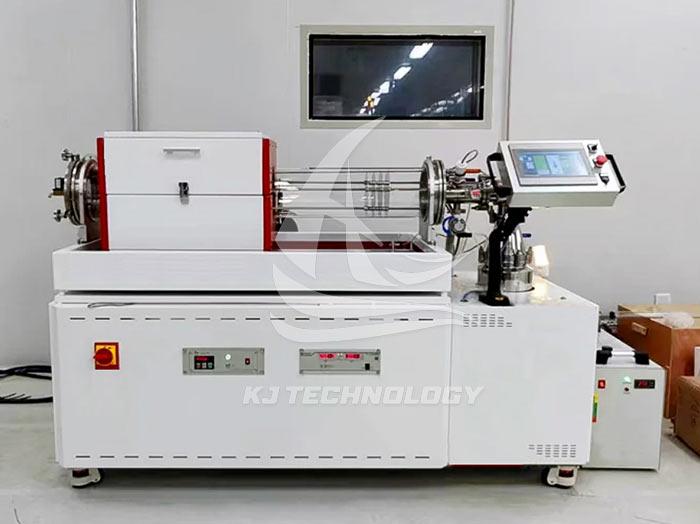Precautions for operating laboratory graphite vacuum furnace
 08-06-2025 Author: KJ technology
08-06-2025 Author: KJ technology
The operation of the laboratory graphite vacuum furnace must strictly follow safety regulations and process requirements to avoid equipment damage, experimental failure, or personnel injury. The following are key precautions during the operation process, covering the entire process before, during, and after the experiment:
1. Preparation before the experiment: Ensure safety and experimental quality
Equipment inspection
Vacuum system: Check the oil level (at 1/2~2/3 of the window) and oil quality (clear without emulsification) of the vacuum pump, and confirm that the pump body has no oil leakage or abnormal noise. Test the accuracy of the vacuum gauge to ensure that the maximum vacuum degree can reach the nominal value of the equipment (such as 10-5Pa).
Cooling system: Check the water level and temperature of the chiller (usually maintained at 15-25 ℃), and confirm that the water circuit is not blocked or leaking. If air cooling is used, the dust on the cooling fan needs to be cleaned.
Electrical system: Check if the power cord and heating element wiring are loose, and confirm that the insulation resistance is ≥ 1M Ω (measured with a megohmmeter).
Furnace cleaning: Use alcohol swabs to wipe the inner walls of the furnace, graphite heating elements, and sample racks to avoid residual contamination of the samples or local overheating.
sample preparation
Size adaptation: The sample size should be smaller than the effective space of the furnace (such as Φ 100 × 200 mm) to avoid short circuits or uneven temperatures caused by contact with heating elements or furnace walls.
Pre treatment: Metal samples need to be cleaned of oil stains and oxide layers (such as sandpaper polishing or acid washing); Ceramic samples need to be dried (at 100-120 ℃ for 2 hours) to prevent cracking caused by moisture evaporation.
Placement method: Powder samples need to be pressed into shape (such as cold pressing, isostatic pressing) to avoid scattering; The block shaped sample needs to be carried by a graphite crucible to prevent direct contact with the heating element.
Parameter settings
Temperature curve: Set the heating rate (such as metal ≤ 10 ℃/min, ceramic ≤ 5 ℃/min), insulation time (such as hard alloy requiring insulation for 2-4 hours), and cooling rate (such as natural cooling or forced cooling by inflation) according to the material characteristics.
Vacuum degree: Active metals (such as titanium) require 10-3Pa or less, while ordinary metals (such as copper) can be relaxed to 10-2Pa.
Atmosphere control: If inert gas (such as argon) needs to be filled, it is necessary to first evacuate to below 10-3Pa, and then slowly inflate to the target pressure (such as 0.1 MPa).
2. Operation in the experiment: monitoring and adjustment
Vacuum pumping stage
Sequential operation: Close the furnace door first, then start the mechanical pump to draw low vacuum (to 10-1Pa), and finally start the molecular pump to draw high vacuum (to 10-5Pa).
Leakage inspection: If the rate of vacuum degree decrease is greater than 0.5 Pa/min, the experiment needs to be paused to check whether the furnace door sealing ring, observation window or vacuum valve is leaking.
Avoid contamination: When vacuuming, do not open the furnace door or touch the sample to prevent external gases or impurities from entering.
Heating and insulation stage
Temperature monitoring: Real time monitoring of the furnace temperature through thermocouples or infrared thermometers. If the temperature fluctuation is greater than ± 5 ℃, the heating power needs to be adjusted or the cooling water flow rate needs to be checked.
Pressure control: If a specific pressure (such as hot isostatic pressure) needs to be maintained, the inflation rate needs to be accurately adjusted through a gas flow meter.
Emergency response: If smoke is detected from the sample, the heating element turns red abnormally, or the vacuum pump noise increases, immediately press the "emergency stop" button, cut off the power, and investigate the cause.
cooling stage
Natural cooling: Suitable for materials sensitive to temperature gradients (such as certain ceramics), it is necessary to maintain a vacuum environment until the furnace temperature drops below 100 ℃.
Forced cooling: If rapid cooling is required, argon gas can be filled to accelerate cooling, but the inflation rate should be controlled (≤ 0.05 MPa/min) to prevent sample cracking.
Do not open the furnace: Do not open the furnace door when the furnace temperature is above 50 ℃ to avoid scalding or oxidizing the sample.
3. Post experiment maintenance: Extend equipment lifespan
Furnace cleaning
Metal samples: After the furnace temperature drops to room temperature, clean the graphite crucible and the inner wall of the furnace with a soft bristled brush to avoid short circuits or corrosion of the heating element.
Ceramic samples: Use a vacuum cleaner to remove powder residue and avoid scratching with hard objects to prevent damage to the graphite surface.
Corrosive materials: If sintering corrosive substances such as sulfur and halogens, it is necessary to wipe the furnace with alcohol and ventilate and dry for more than 24 hours.
equipment maintenance
Vacuum pump: Replace the vacuum pump oil and clean the oil mist filter every 500 hours of operation; Molecular pumps require regular inspection of bearing lubrication.
Cooling system: Clean the filter screen of the water cooler every quarter and replace the coolant (such as ethylene glycol water mixture); The air-cooled system needs to clean the dust on the heat sink.
Heating element: If the graphite heating element has cracks or an excessively thick oxide layer (>1 mm), it should be replaced in a timely manner to avoid local overheating caused by increased resistance.
Data recording and archiving
Record experimental parameters (temperature, vacuum degree, time), sample status, and abnormal phenomena to provide a basis for subsequent experimental optimization.
Save electronic data such as temperature curves and vacuum degree change curves for easy traceability and analysis.
4. Security protection: dual protection of personnel and equipment
Personal Protection
Wear protective gloves (heat-resistant, anti cutting), goggles (anti splash), and dust masks (anti powder inhalation) during operation.
Do not wear loose clothing or jewelry to prevent entanglement with rotating components such as molecular pumps.
emergency measure
Fire: When a fire breaks out in the furnace, immediately cut off the power supply, fill argon gas to extinguish the fire, and prohibit using water or carbon dioxide fire extinguishers.
Electric shock: In case of an electric shock accident, first cut off the power supply, then use an insulating object (such as a wooden stick) to remove the wire, perform cardiopulmonary resuscitation, and call the emergency number.
Vacuum pump malfunction: If the vacuum pump is stuck or overheated, immediately shut down and disconnect the power supply. After cooling down, check the oil level, belt tension, or motor winding.
Training and Certification
Operators need to undergo professional training, familiarize themselves with equipment principles, operating procedures, and emergency response plans.
Regularly organize safety drills to ensure that personnel master key skills such as using fire extinguishers and locating emergency stop buttons.








